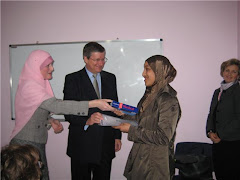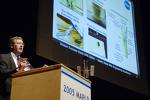
'Scottish Royal College of Surgeons - Surgeons Hall'
During the ‘Teaching English for Medicine’ course which I recently attended in Edinburgh, we were fortunate enough to listen to a talk given by J.S Moffat M.A (St Andrews). I would like to share my notes with you. May Allah have mercy on me if I noted anything inaccurately.
In the Dark Ages Scotland was not densely populated and hunter gatherers and early farmers didn’t travel much so although there were infections, they didn’t spread easily. Illnesses were treated by Celtic Shamen, primitive medicine men who used magic stones, incantations and herbal medicine.
In the 1100’s, boats came from Ireland bringing Christianity and disease. Christian monasteries and abbeys had areas for the monks to care for the poor and the sick. The medieval apothecaries dispensed herbs and chemicals to treat illness.
St Margaret of Scotland encouraged pilgrims to Scotland to worship at the shrine of St Andrew and this meant that people began to move around Europe causing leprosy to be introduced to Scotland. This epidemic lastest into the 1700’s, gradually clearing from South to North.
In 1349, ‘The sickness’, ‘Bubonic Plague’ or ‘The Black Death’ arrived in Scotland, possibly brought by the English army. Perhaps mercifully, for the many people struck by the plague, one thing they could almost certainly be sure of was that their pain would not last long. John of Forlan wrote;
“.... by Gods will, this evil lead to a strange and unwanted kind of death, insomuch that the flesh of the sick was somehow puffed out and swollen, and they dragged out their earthly life for barely two days”.
Plague doctors wore scary masks like that in the photo and as there was no cure, people were quarantined in tented communities outside the city walls until it was there turn to join the mass graves.
The people of the time believed that it was coming in by ship and quarantined ships for 40 days on the island of Beachcombe before being allowed into port. They also believed that it could be carried on clothes and those arriving in the port were made to strip and their clothes burnt.
In 1578, Robert Henrison was believed to be the first doctor appointed to advise Edinburgh city officials about how to deal with the epidemic.
King James the 4th of Scotland was an intellectual king with a desire for knowledge and he favoured medical practice outside the monasteries ratifying a royal charter of privileges in 1506.
In 1505, the Barber Surgeons of Edinburgh were formally incorporated as a Craft Guild of the city and this recognition is embodied in the Seal of Cause (or Charter of Privileges) which was granted to the Barber Surgeons by the Town Council of Edinburgh on 1st July 1505.
The Seal of Cause is a remarkable document. It clearly established the role of the Incorporation of Barbers and Surgeons as a body concerned with the maintenance and promotion of the highest standards of surgical practice and this remains the prime purpose of the great international surgical fellowship of the Royal College which has developed from the Incorporation.
The Seal of Cause conferred various privileges and imposed certain crucially important duties, the most important of these, entirely appropriate today, is
"... that no manner of person occupy or practise any points of our said craft of surgery... unless he be worthy and expert in all points belonging to the said craft, diligently and expertly examined and admitted by the Masters of the said craft and that he know Anatomy and the nature and complexion of every member of the human body... for every man ocht to know the nature and substance of everything that he works or else he is negligent."
One of the most important landmarks in the early history of the Barber Surgeons is the Royal Charter granted to them by Mary Queen of Scots, the grand-daughter of James IV, on 11th May 1567. This notable document - which is often referred to as the "Barber Surgeons’ letter of exemption", formally relieved members of the Incorporation from the obligation to bear arms in defence of the realm but obliged them to treat sick and wounded soldiers in the Queen’s armies - is the first formal statement anywhere of the non-combatant role of the army doctor.
The 15th century also saw an epidemic of syphilis which was believed to have come via England from Naples, another terminal disease, which although treated with mercury, was ultimately fatal. Healing stones and holy wells were still widely used although instruments found at a hospice during an archaeological dig at Soutra Aisle near Edinburgh closely resembled many of the modern day instruments.
In the 16th century, the Scots had to go abroad if they wanted to study medicine. They primarily chose the Leyden University in Holland, Pisa in Italy and the University of Paris.
With the reformation of the Catholic church around 1560, it was decided that the monks no longer treated the sick appropriately.
The 17th century saw the Scottish witch trials resulting in thousands of deaths based on the belief that women using herbal medicine were placing curses on individuals causing stillbirths and illnesses.
At this time, surgeons avoided operations as there were no anaesthetics and a majority of operations ended in death from infection. This was not good for the surgeons’ reputation and therefore they stuck to removing teeth, cupping (hijama), binding the dead and healing wounds. They charged fees for these services but were seen as lower than physicians.
In the late 17th century, Edinburgh University of Physicians was founded but they were still unable to teach medicine.
In 1707 the Scottish and English parliaments joined together and moved to London but lots of intellectual activity remained. The Scottish Enlightenment was the period in 18th century Scotland characterised by an outpouring of intellectual and scientific accomplishments. The first, non-religious institution in Edinburgh was set up by lay people and in 1726 the school of medicine was born. Although the first students were from Scotland, its reputation grew as it was cheap no religious tests were applied, unlike other colleges which were denomination biased. In 1730, 83 students enrolled in the anatomy class but by 1790, this number had risen to 500.
1729 saw the Royal Infirmary teaching hospital built, attracting many radical thinkers to the school of medicine. Students came from all over Europe.
The story of Burke and Hare was recounted at this point and will be highlighted in my next post.
In the 1920’s the British Empire was huge and the world was the Scots’ doctors’ oyster. Between the 18th and 19th century, 87% of the world’s doctors were Edinburgh graduates.
Notable graduates included:
Sir James Wiley, personal physician to the Russian Tsar
James Lynd, naval surgeon involved in the discovery of lemons to treat scurvy and
Sir John Pringle who proposed the concept that the wounded in battle should be free from attack which was adopted later in the Geneva Convention.



No comments:
Post a Comment